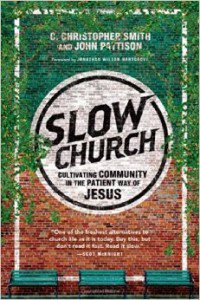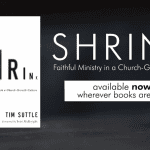_____________________________________
“If I could require every pastor in America to read Slow Church, I would. If churches would read this book and heed its advice, then ironically, I think the church would fast become a much more meaningful part of God’s mission of redemption.”
_____________________________________
If the church has a future in the Western World, and if that future church is to provide any sort of alternative imagination to the current cultural values and norms of society, and if that future is to be faithfully modeled on the in-breaking Kingdom of God we find inaugurated in the life and teachings of Jesus, then it will need to look like Slow Church.
Of all the symbols of the late 20th and early 21st Century’s fascination with speed—fast cars, fast computers, fast Internet, fast service—perhaps the most visible among them is Fast Food. It is the apotheosis of a culture that seems unable to recognize the fact that it’s own paranoia about the future comes at the expense of the present moment. We have no “now” anymore. That’s why we eat fast food. Only a person who is in a tremendous hurry to get to the next thing would put up with food as bad as what you buy at McDonald’s.
The authors of Slow Church, C. Christopher Smith and John Pattison, assume the tenets of Geord Ritzer’s “McDonaldization” of the church, and argue that the pattern the church has chosen to follow in recent history is that of efficiency, predictability, calculability (quantifiable results) and control. Smith and Pattison are certainly not the first to argue that the American church has become a fast-food version of religion. But they are among the first to take the analogy of Slow Food, and make it the lens through which to view our collective ecclesiology.
Slow Food was the obvious and the most visible of all of the “slow” reactions to the culture of fast (slow money, parenting, farming, gardening, reading, design, art, and so on). Slow Food has grown into a genuine worldwide movement, with 1,300 local chapters in 50 countries with over 100,000 members.

Smith and Pattison believe it’s time to think about Slow Church: Cultivating Community in the Patient Way of Jesus. They envision a church inspired and animated by the language and philosophy of the Slow Food Movement. By running their vision of the church through the lens of the “slow” philosophy, Smith and Pattison are able to make important critiques of the current state of the church in our society. But more importantly, the “slow” values and practices provide fertile ground in which to cultivate a new imagination for local versions of the church–versions that can actually hope to grow into genuine alternatives to the culture of speed.
Slow Church is fittingly organized as a three-course meal.
First Course: Ethics
Terroir: Ethics begins with le goût de terrior—the taste of the place. True ethics does not hang in mid-air, but is grounded in a particular time and place. Slow Churches will not attempt to impose their will on a neighborhood. Rather, they will embrace the history and dynamics already in existence. Only when a community is deeply known by the church and her members (think parish), will that church know how to be part of God’s mission in that place.
Stability: Ethics requires stability. Only people who plan to stick around for the long haul will have the discipline to do the right thing even when it’s difficult. The neighborhoods we inhabit are the places to which we have been given. Our neighbors are meant to become part of our lives. As individual persons, our lives are meant to become caught up in the life of the community as a whole. Slow Church can’t work if you constantly move around.
Patience: Ethics requires patience—the ability to do nothing when you don’t know what to do. American culture is about progress. Kingdom work is about assuming certain postures and modes of being as we patiently wait on God to act. This will require not only discipline, but also a certain amount of suffering. We cannot alleviate the suffering of everyone in our community. But we can stand in solidarity with them, so they are not alone.
Second Course: Ecology
Wholeness: The kingdom of God is about God’s entire diverse creation flourishing in wholeness. The problem comes when we do not appreciate the difference between diversity and fragmentation. All of life is connected in and through God, in ways that we cannot even begin to imagine or understand. In buying-in to the dualisms of our culture, we join the bipolar fighting—liberal/conservative, American/alien, in/out—and forget that Jesus had this annoying habit: any way you could divide the world into in-groups and out-groups, he’d stand with the wrong side. Lepers, Gentiles, tax collectors, adulterers, foreigners, the unclean… these are the people Jesus embraced in an effort to model the wholeness God requires. This wholeness is integral to the gospel, and the life of the Slow Church.

Work: In order for the land to flourish, it requires people who will work the land. In order for people to flourish, they need good work to do with their hands. These two realities are meant to work together. Every farmer knows they belong to the land. Nearly everyone else in our society has forgotten. Slow Churches will find ways to help their people connect the work they do in their everyday lives, to the very creation that sustains them.
Sabbath: Only slaves work seven days a week. Sabbath is the proclamation of God’s people that we are free, that we are not generating our own lives, but we are receiving our lives from a generous God. Sabbath isn’t just the cessation of work, it it’s the cessation of restlessness (Brueggemann), and the intentional delight of God’s people in the delectability of now. This time, this day, this moment, this food, these people—these are the things with which Sabbath concerns itself. These are the things Sabbath can teach us to see and value.
Third Course: Economy.
Abundance: The story of our culture is bound up in scarcity. The story of God is bound up in abundance. The Slow Church will learn how to draw their lives from the latter.
Gratitude: A generous God deserves a thankful people. Only a people who have become convinced that they are self-sustained would have the audacity to live without gratitude.
Hospitality: God has come to us in friendship. We must go to one another in the same way. Learning to create space in our own lives within which to welcome the other—those who are not like us—is simply the imitation of God. The Slow Church takes extreme time and care to cultivate a spirit of hospitality, and its corresponding practices.
The book ends by playing with the metaphor of “dinner table conversation as a way of being church.” The obvious allusions to communion, the last supper, the body of Christ, the bread of life fund this chapter as it draws the book together in an ecclesial vision for which we should all hunger. All true church is potluck. Our lives are meant to be as well, both personally and communally. The Slow Church will never forget to linger over a good meal, delighting in the relationships and the goodness of life.
I’ve heard the critiques of Slow Church. It’s Luddite. Unrealistic. Utopian. A recent review in The Christian Century is appreciative of the work as a whole, but is critical of Slow Church on the grounds that while its authors critique the commodification of church and the wholesale adoption of the cultural value of speed, they simultaneously “call for churches to become captains of neighborly industry” The reviewer protests on grounds that, “to apply for government grants and to sponsor commercial enterprises would make churches subject to government rules and regulations, as well as the secular standards of management and efficiency that they so vigorously protest.”
I understand the critique, because I hear it often in my own work. However, I think the review fails to take into account the way that Christians are meant to engage the world and its systems on the local level. To have a critique of capitalism does not mean one should attempt to drop completely out of the money system—as though that is even possible. This is precisely the kind of sectarianism—especially given the Anabaptist influence on their work—Smith and Pattison are wise to avoid.
We can’t drop out of culture. We can only embody a completely different way of being human within that culture. Yes we are implicated by our cooperation with corrupt systems. But this is unavoidable. So our participation in the systems of education, economics, health, government, and so on is meant to be our primary form of bearing witness. Our involvement in the systems of the world will be an atypical involvement; an involvement that comes “in the way of Jesus” and thus is meant to transform those systems, at least in their local iterations. Only a little salt is needed to season the whole dish. Even a tiny, yet vibrant small church can change the flavor of the entire community.
Conversely, the reviewer’s vision for the future of the church is the idea that scares me the most. He writes, “I suspect that the future of churches, like the future of education, belongs to hybrid models that promote the use of anything that works.” Anything that works is simply not a phrase I could ever imagine Jesus using. This is the kind of pragmatism that got us into the fast church predicament in the first place. Smith and Pattison ably critique it.*
I don’t remember the last time I read a book with which I agreed more completely. I am not prone to this phenomenon, but I found myself in agreement with every major premise put forth in Slow Church. I could argue with many of the details, but not with the big ideas those details support. I could try and mine for inconsistencies, but every book has those.
The truth is that I don’t feel any compunction to take away from the fact that Smith and Pattison have really done something remarkable in this book. The idea is novel—using Slow Food as a model for thinking about the church—but there are many ways this project could have gone bad. Smith and Pattison don’t fall into the usual traps that often turn novel projects like this into facile rationalizations of liberal Christianity. My neck is sore from nodding my approval, and I believe they offer a lot for the church to think about.
If I could require every pastor in America to read Slow Church, I would. If churches would read this book and heed its advice, then ironically, I think the church would fast become a much more meaningful part of God’s mission of redemption in the world.
Tim Suttle, Summer – 2014.
*I didn’t want to taint the review with my own agenda, so I’ll interject here at the end. This kind of pragmatism lies at the heart of what is killing the church’s influence on the culture, and it is the primary reason I wrote the book Shrink: Faithful Ministry in a Church Growth Culture (Sept. 2014). The church is not called to be successful—to do whatever works. The church is called to be faithful, and to leave things like numbers and success in the hands of God.













